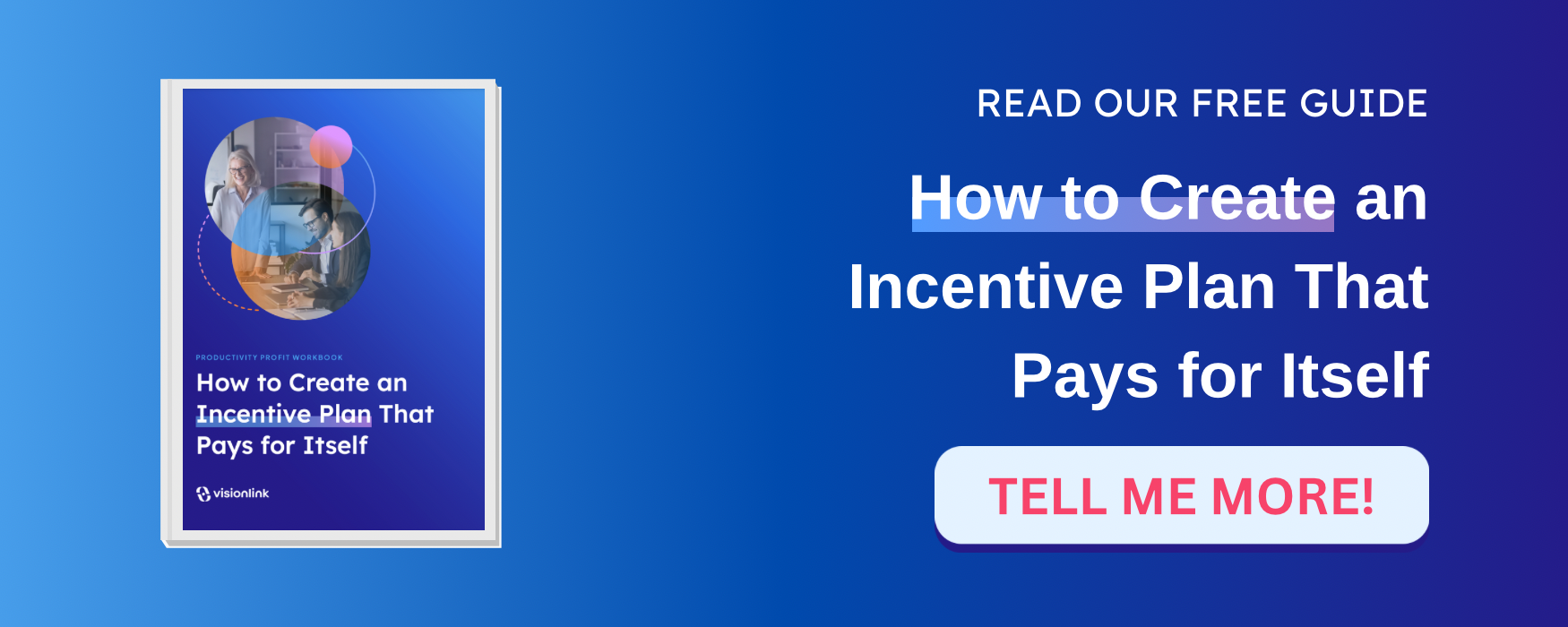
Effective incentive plan design can only occur if your approach is built on the right premise. In other words, if the premise of your plan is wrong, the plan will fail. That said, the success of an employee incentive is not assured just because you start with the right premise. Even a strong foundation can’t offset poor construction, whether you are building a house or a rewards plan. So, what do you do? How do you set an employee incentive plan up for success and how do you determine whether the approach you’ve taken is effective?
As with so many other things, to achieve success you have to apply the right principles when you construct your incentive plan and then use the right criteria for evaluating the effectiveness of your approach. In our work at VisionLink, there are three basic standards we think every incentive strategy must meet to be considered successful.
1. They Reward Outcomes, not Behaviors. For a very long time, our firm has been advocating that companies shift from “paying incentives” to “sharing value.” Perhaps it seems like a mere semantic difference but it is not. The term incentive implies that a certain amount of money can motivate employees to perform—and so plans should be designed to impact people’s behavior. Certainly, research has refuted that idea. That is not to say that rewards have no impact on motivation—because they do. However, in a successful incentive plan, behavioral change is the byproduct of the design not its primary aim.
The value-sharing approach is rooted in a “wealth multiplier” pay philosophy where business owners are completely committed to a value creation model when it comes to building a pay strategy. In this environment, the company starts by determining how value creation will be defined in the organization. It may be a threshold of profitability, a shareholder value metric, a revenue target or something else. But from there, the company’s stance is that it will reward those employees who create value—often without putting limits on the earnings potential. In other words, all stakeholders benefit from the wealth multiple they help create and sustain. This is an outcome-based approach instead of one tied to behavior and motivation.
Company leaders that share value instead of paying incentives are sending a signal to their employees that says essentially this: “We consider you a growth partner in our business. As a result, we think you should share in the value you help create. This is how we define value creation in our business and this is the part you are responsible for in your role. If you help us achieve these outcomes, here is how you will benefit.” The value-sharing approach completely aligns the focus of employees with that of company owners and creates a more unified financial vision for growing the business.
2. They are Self-Financing. This is a natural extension of rewarding outcomes instead of behavior. In fact, a value-sharing approach can only work if plan benefits pay for themselves. This simply means that value is paid out of the value created beyond the threshold defined in the company’s pay philosophy. If sufficient value hasn’t been created, then no benefits are paid—or they are proportionally reduced.
One of the ways some organizations go about ensuring a self-financing outcome is to state that all value-sharing plan benefits will be paid out of productivity profit. And the higher the productivity profit is, the more employee earnings can increase. Productivity profit is the net income surplus the company can attribute to the productivity and performance of its human capital as opposed to the result of other assets at work in the business. It is a way of identifying whether or not the value creation threshold has been met. (For a deeper dive into productivity profit, read How CEOs can Measure their ROI on Compensation.
3. They Reward both Short and Long-Term Performance. Often, prospective clients will ask us which is more important for a business to have—a short or long-term incentive plan. To which we usually respond, “Yes!” At VisionLink, our philosophy is that you should have one overriding value-sharing philosophy and strategy that measures and rewards the value created within two different periods: 12 months or less and longer than 12 months. By keeping your plans under the umbrella of one governing premise, you ensure that there is a balanced approach to value creation in the business. In an article several years ago for Strategy+Business, Ken Favaro offered a perspective about organizational growth that demonstrates why this makes sense:
"Peter Drucker once wrote that the manager’s job is to keep his nose to the grindstone while lifting his eyes to the hills. He meant that every business has to operate in two modes at the same time: producing results today and preparing for tomorrow.
"But 'preparing for tomorrow' really means investing in the future, an expensive and uncertain proposition. It demands taking an incremental hit to today’s performance in exchange for an unguaranteed payoff. Meanwhile, you have to meet your previous promises of big gains to have the wherewithal to continue investing. But that wherewithal will soon be lost if meeting those promises means forgoing new investments that are essential to future results. Drucker’s dictum is not only an acrobatic feat, but a managerial one as well."
It will be difficult to achieve what Favaro and Drucker propose here if your pay strategy is working at odds with the "double vision" you want your people to have. Adopting one value-sharing philosophy that rewards two separate performance periods keeps employee focus in balance. The short-term part ensures employees pay attention to the revenue engine of the company that needs to be maintained year to year while the business works on leveraging its business model for growth. The long-term focus protects the organization from driving bad profits instead of good profits. Bad profits are those that are not sustainable because they are produced as a result of eroding something of lasting value—customer, vendor or community relationships for example. To understand bad profits, think Wells Fargo.
In addition, a balanced value-sharing approach helps the company attract and retain premier talent and then instill in them a kind of performance equilibrium in their approach to their roles. They see clearly the priority they have to “keep their noses to the grindstone while lifting their eyes to the hills,” as Drucker suggested. Knowing what LTIP options are available can help you determine which kind of long-term value sharing approach will help encourage your people to focus on sustained performance and not just temporary bursts of productivity.
So, if your “incentive plans” meet those three criteria, then I think it is fair to say you have a successful approach. Note there is nothing here about specific metrics for revenue or profit increase…or other traditional measures usually referenced when evaluating an incentive plan’s effectiveness. Those things should be considered natural byproducts of a design rooted in a wealth multiplier philosophy that rewards value creation. When employees are paid in a way that unifies their focus and aligns their interests with those of shareholders, many such things tend to take care of themselves.
Ready to Get Started?
When it comes to building a compensation strategy, you can trust that VisionLink knows what works and what doesn’t. We are ready to share that knowledge with you.
Stay Connected
Receive free, ongoing access to updates on compensation and talent trends, reports, events, and more.


